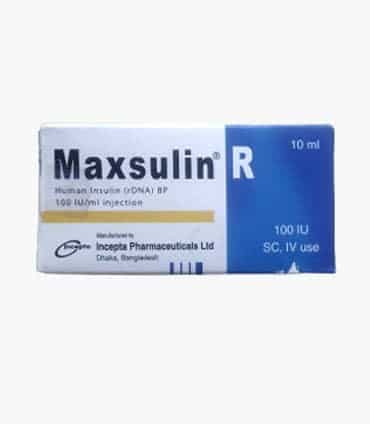Maxsulin R | SC Injection | 10 ml | 1 pcs
৳ 415.00
Brand Name: Maxsulin R SC Injection
Generic: Insulin Human [Fast-Acting]
100 IU/ml
Manufacturer: Incepta Pharmaceuticals Ltd.
10 ml vial: ৳ 415.00
3 ml cartridge: ৳ 222.00 (4’s pack: ৳ 888.00)
Indications
Pharmacology
The blood glucose lowering effect of insulin is due to the facilitated uptake of glucose following binding of insulin to receptors on muscle and fat cells and to the simultaneous inhibition of glucose output from the liver. Insulatard is a long-acting insulin. Onset of action is within 1½ hours, reaches a maximum effect within 4-12 hours and the entire time of duration is approximately 24 hours.
Insulin in the blood stream has a half-life of a few minutes. Consequently, the time-action profile of an insulin preparation is determined solely by its absorption characteristics. This process is influenced by several factors (e.g. insulin dosage, injection route and site, thickness of subcutaneous fat, type of diabetes). The pharmacokinetics of insulins is therefore affected by significant intra- and inter-individual variation
Dosage
Administration
For subcutaneous use. Insulatard is usually administered subcutaneously in the thigh. If convenient, the abdominal wall, the gluteal region or the deltoid region may also be used. Subcutaneous injection into the thigh results in a slower and less variable absorption compared to the other injection sites. Injection into a lifted skin fold minimises the risk of unintended intramuscular injection.
Keep the needle under the skin for at least 6 seconds to make sure the entire dose is injected. Injection sites should be rotated within an anatomic region in order to avoid lipodystrophy. Insulin suspensions are never to be administered intravenously. Insulatard is accompanied by a package leaflet with detailed instruction for use to be followed. The vials are for use with insulin syringes with corresponding unit scale. When two types of insulin are mixed, draw the amount of fast-acting insulin first, followed by the amount of long-acting insulin.
Side Effects
Low blood sugar (hypoglycaemia) is a very common side effect. It may affect more than 1 in 10 people.
Signs of low blood sugar: Cold sweat; cool pale skin; headache; rapid heartbeat; feeling sick; feeling very hungry; temporary changes in vision; drowsiness; unusual tiredness and weakness; nervousness or tremor; feeling anxious; feeling confused; difficulty in concentrating.
Pregnancy & Lactation
Precautions & Warnings
- If you have trouble with your kidneys or liver, or with your adrenal, pituitary or thyroid glands.
- If you exercise more than usual or if you want to change your usual diet, as this may affect your blood sugar level.
- If you are ill, carry on taking your insulin and consult your doctor.
- If you are going abroad, travelling over time zones may affect your insulin needs and the timing hereof.
Use in Special Populations
Use in children and adolescents: Can be used in children and adolescents.
Use in special patient groups: If you have reduced kidney or liver function, or if you are above 65 years of age, you need to check your blood sugar more regularly and discuss changes in your insulin dose with your doctor.
Therapeutic Class
Storage Conditions
| Generic Name | Insulin Human [Fast-Acting] |
|---|---|
| bottle | 10 ml |
Only logged in customers who have purchased this product may leave a review.












Reviews
There are no reviews yet.